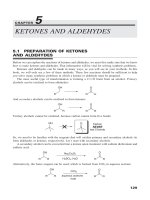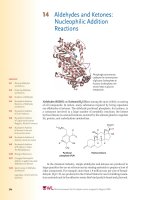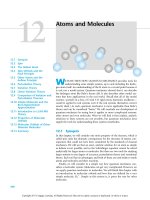Ebook Modern physical organic chemistry Part 1
Bạn đang xem bản rút gọn của tài liệu. Xem và tải ngay bản đầy đủ của tài liệu tại đây (2.74 MB, 159 trang )
New trends in supramolecular chemistry
New trends
in supramolecular chemistry
Edited by
Volodymyr I. Rybachenko
Supramolecular
Chemistry
Self-organization
Nanotechnology
Molecular
recognition
New trends
in supramolecular chemistry
Collected research papers
Edited by
Volodymyr I. Rybachenko
Donetsk
«East Publisher House»
2014
УДК 541.1+547
О 80
Reviewers: Opeida I.A. – professor
Grzesiak Piotr – professor
Recommended for printing academic councils of L. Litvinenko Institute
Physical Organic and Coal Chemistry National Academy of Science
of Ukraine & Faculty of Chemistry Adam Mickiewich University in
Poznań, Poland
О 80 New trends in supramolecular chemistry [collected research papers]
Edited by V.I. Rybachenko.
Donetsk: «East Publisher House»
Ltd, 2014. – 356 p.
ISBN 978-966-317-208-8
Supramolecular chemistry it is interdisciplinary scientific field. The monograph
presents various lines of research in the field of nanotechnology, interaction and
self-organization of molecules.
Супрамолекулярная химия это междисциплинарное научное поле. В
монографии представлены различные направления исследований в области
нанотехнологий, взаимодействия и самоорганизации молекул.
УДК 541.1+547
О 80
ISBN 978-966-317-208-8
© Collective of authors, 2014
Contents
List of contributors ............................................................................... 5
Supramolecular systems based on lanthanide complexes
with modified calix[4]arenes as fluorescent receptors
for metal cations .................................................................................. 11
Natalya Rusakova, Olga Snurnikova and Ninel Efryushina
Molecular complexes of carbohydrate-containing metabolites with
antibiotics ............................................................................................ 49
Leonid Yakovishin, Vladimir Grishkovets, Elena Korzh,
Grzegorz Schroeder and Volodymyr Rybachenko
Phenylboronic acids-containing nanoparticles .................................... 71
Alicja Pawełko, Agnieszka Adamczyk-Woźniak
and Andrzej Sporzyński
Boronic acids immobilized on diol-functionalized resins .................. 85
Łukasz Włoszczak, Krzysztof M. Borys,
Agnieszka Adamczyk-Woźniak and Andrzej Sporzyński
Electronic structure of the organic compounds and their reactivity
in the reactions of radical hydrogen atom tear by HO2· radical ....... 103
A.F. Dmitruk, L.F. Pikula, T.V. Kryuk and Yu.O. Lesishina
Application of mesoporous silica nanoparticles for drug delivery ... 113
Dawid Lewandowski and Grzegorz Schroeder
Surface modification of natural halloysite nanotubes. The hybrid
materials for nanotechnology ............................................................ 147
Joanna Kurczewska, Agnieszka Michalska, Kajetan Pyrzyński
and Grzegorz Schroeder
3
Acid-base equilibria in ‘oil-in-water’ microemulsions.
The particular case of fluorescein dyes ........................................... 159
Nikolay O. Mchedlov-Petrossyan, Natalya V. Salamanova
and Natalya A. Vodolazkaya
Functional polymers forming complexes with metal ions .............. 185
Michał Cegłowski and Grzegorz Schroeder
Application of dilational rheology for analyze the properties
of interfacial layers supramolecular systems .................................. 205
Svetlana Khil’ko and Volodymyr Rybachenko
Oligomerization thermodynamics of fatty alcohols
and carboxylic acids at the air/water interface.
Quantum chemical approach .......................................................... 217
E. S. Fomina, E. A. Belyaeva and Yu. B. Vysotsky
Inverse phase transfer catalysis in organic synthesis ...................... 251
Viktor Anishchenko, Volodymyr Rybachenko,
Grzegorz Schroeder, Konstantine Chotiy and Andrey Redko
Solubilization of carbon nanotubes in water
and in organic solvents .................................................................... 281
Grażyna Bartkowiak and Grzegorz Schroeder
Thin CVD diamond films – synthesis, properties, applications ...... 303
Robert Bogdanowicz
Design and reactivity of alpha nucleophiles for decontamination
reactions: relevance to functionalized surfactants .......................... 327
Namrata Singh, Yevgen Karpichev, Kamil Kuca
and Kallol K. Ghosh
4
List of contributors
Agnieszka Adamczyk-Woźniak
Warsaw University of Technology
Faculty of Chemistry
Noakowskiego 3
00-664 Warsaw, Poland
Viktor Anishchenko
L.M. Litvinenko Institute of physical-Organic and Coal Chemistry
National Academy of Science of Ukraine
Department of Spectrochemical Researches
R. Luxemburg 70
81-134 Donetsk, Ukraine
Grażyna Bartkowiak
Adam Mickiewicz University in Poznań
Faculty of Chemistry
Umultowska 89b
61-614 Poznań, Poland
E. A. Belyaeva
Donetsk National Technical University
58 Artema Str.
83000 Donetsk, Ukraine
Robert Bogdanowicz
Gdansk University of Technology
Faculty of Electronics, Telecommunications and Informatics
Gabriela Narutowicza 11/12
80-233 Gdańsk, Poland
5
Krzysztof M. Borys
Warsaw University of Technology
Faculty of Chemistry
Noakowskiego 3
00-664 Warsaw, Poland
Michał Cegłowski
Adam Mickiewicz University in Poznań
Faculty of Chemistry
Umultowska 89b
61-614 Poznań, Poland
Konstantine Chotiy
L.M. Litvinenko Institute of physical-Organic and Coal Chemistry
National Academy of Science of Ukraine
Department of Spectrochemical Researches
R. Luxemburg 70
81-134 Donetsk, Ukraine
A.F. Dmitruk
Donetsk National University of Economics and Trade named after
Mykhailo Tugan-Baranovsky
Schersa Str. 31
83050 Donetsk, Ukraine
Ninel Efryushina
A.V. Bogatsky Physico-Chemical Institute NAS of Ukraine
Lustdorfskaya Doroga 86
65080 Odessa, Ukraine
E. S. Fomina
Donetsk National Technical University
Artema Str.
83000 Donetsk, Ukraine
Kallol K. Ghosh
School of Studies in Chemistry
Pt. Ravishankar Shukla University
492010 Raipur (C.G), India
6
Vladimir Grishkovets
V.I. Vernadsky Taurida National University
Vernadsky Ave. 4
Simferopol 95007, Crimea, Ukraine
Yevgen Karpichev
L.M. Litvinenko Institute of physical-Organic and Coal Chemistry
National Academy of Science of Ukraine
Department of Spectrochemical Researches
R. Luxemburg 70
81-134 Donetsk, Ukraine
Svetlana Khil’ko
L.M. Litvinenko Institute of Physical-Organic and Coal Chemistry
National Academy of Sciences of Ukraine
R. Luxemburg Street 70
Donetsk 83114, Ukraine
Elena Korzh
Sevastopol National Technical University
Universitetskaya Str. 33
Sevastopol 99053, Crimea, Ukraine
T.V. Kryuk
Donetsk National University of Economics and Trade named after
Mykhailo Tugan-Baranovsky
Schersa Str. 31
83050 Donetsk, Ukraine
Kamil Kuca
University of Hradec Kralove
Faculty of Science,
Department of Chemistry
Rokitanskeho 62
50003 Hradec Kralove, Czech Republic
7
Joanna Kurczewska
Adam Mickiewicz University in Poznań
Faculty of Chemistry
Umultowska 89b
61-614 Poznań, Poland
Yu.O. Lesishina
Donetsk National University of Economics and Trade named after
Mykhailo Tugan-Baranovsky
Schersa Str. 31
83050 Donetsk, Ukraine
Dawid Lewandowski
Adam Mickiewicz University in Poznań
Faculty of Chemistry
Umultowska 89b
61-614 Poznań, Poland
Nikolay O. Mchedlov-Petrossyan
V.N. Karazin Kharkov National University
Svoboda Sq. 4
61022 Kharkov, Ukraine
Agnieszka Michalska
Delta Innovations and Implementation Company
Krupczyn 5
63-140 Dolsk , Poland
Alicja Pawełko
Warsaw University of Technology
Faculty of Chemistry
Noakowskiego 3
00-664 Warsaw, Poland
L.F. Pikula
Donetsk National University of Economics and Trade named after
Mykhailo Tugan-Baranovsky
Schersa Str. 31
83050 Donetsk, Ukraine
8
Kajetan Pyrzyński
Delta Innovations and Implementation Company
Krupczyn 5
63-140 Dolsk , Poland
Andrey Redko
L.M. Litvinenko Institute of physical-Organic and Coal Chemistry
National Academy of Science of Ukraine,
Department of Spectrochemical Researches
R. Luxemburg 70
81-134 Donetsk, Ukraine
Natalya Rusakova
A.V. Bogatsky Physico-Chemical Institute NAS of Ukraine
Lustdorfskaya Doroga 86
65080 Odessa, Ukraine
Volodymyr Rybachenko
L.M. Litvinenko Institute of physical-Organic and Coal Chemistry
National Academy of Science of Ukraine
Department of Spectrochemical Researches
R. Luxemburg 70
81-134 Donetsk, Ukraine
Natalya V. Salamanova
V.N. Karazin Kharkov National University
Svoboda Sq. 4
61022 Kharkov, Ukraine
Grzegorz Schroeder
Adam Mickiewicz University in Poznań
Faculty of Chemistry
Umultowska 89b
61-614 Poznań, Poland
Namrata Singh
School of Studies in Chemistry
Pt. Ravishankar Shukla University
492010 Raipur (C.G), India
9
Olga Snurnikova
A.V. Bogatsky Physico-Chemical Institute NAS of Ukraine
Lustdorfskaya Doroga 86
65080 Odessa, Ukraine
Andrzej Sporzyński
Warsaw University of Technology
Faculty of Chemistry
Noakowskiego 3
00-664 Warsaw, Poland
Natalya A. Vodolazkaya
V.N. Karazin Kharkov National University
Svoboda Sq. 4
61022 Kharkov, Ukraine
Yu. B. Vysotsky
Donetsk National Technical University
Artema Str. 58
83000 Donetsk, Ukraine
Łukasz Włoszczak
Warsaw University of Technology
Faculty of Chemistry
Noakowskiego 3
00-664 Warsaw, Poland
Leonid Yakovishin
Sevastopol National Technical University
Universitetskaya Str. 33
Sevastopol, 99053, Crimea, Ukraine
10
„New trends in supramolecular chemistry”
Edited by Volodymyr I. Rybachenko
Donetsk 2014, East Publisher House, ISBN 978-966-317-208-8
Chapter 1
Supramolecular systems based on lanthanide complexes
with modified calix[4]arenes as fluorescent receptors
for metal cations
Natalya Rusakova, Olga Snurnikova and Ninel Efryushina
A.V. Bogatsky Physico-Chemical Institute NAS of Ukraine,
Lustdorfskaya Doroga 86, 65080 Odessa, Ukraine
The number of publications devoted to polynuclear complexes of
lanthanides is steadily increasing. The greatest part of works devoted to
heteronuclear complexes of lanthanides with s- and d-elements, in which
interest is dictated primarily by their practical application, especially in
quantum optics and electronics. The effect of s-metals on the 4f-luminescence
was considered in lanthanide-containing compounds that emit in the visible
region of the spectrum. As for publications on lanthanide complexes with
so-called essential d-elements (copper, zinc, cobalt, nickel, chromium, iron,
etc.) the majority of them are devoted to the development of synthetic models
of natural ionophores and sensors for biology and medicine. The range of
publications that focus on the possibility of using multidentate macrocyclic
compounds as a basis for obtaining polynuclear lanthanide complexes is very
limited, which determines the prospects of such research. In particular, it is
related with the search for new photochromic compounds and approaches for
solving the problems of perception of the optical information, including living
systems [1-6]. The main advantage of the use of chromophoric macrocyclic
ligands compared to acyclic analogs is the presence of already formed
molecular cavity preorganized for coordination of lanthanides with appropriate
ionic radii, and attached chromophores capable of efficient absorption of the
exciting light for sensitization of 4f-luminescence [7-10].
After the publication of van Veggel, dedicated to sensitization of intrinsic
luminescence of Nd(III) and Yb(III) in the complexes containing ruthenium
bipyridyl and ferrocene, the use of light-absorbing metal complex chromophores
as sensitizers of 4f-luminescence has attracted the attention of many research
11
Natalya Rusakova, Olga Snurnikova and Ninel Efryushina
groups. The term “metal-containing chromophores” have been used until now.
A lot of articles were published on the effect of d-metal complex chromophores
containing such ions as Pt(II), Ru(II,) Re(I), Os(II), Pd(II), Cr(III) on the
4f-luminescence. Their energy levels are in the range of 13000 - 18000 cm-1 in
most cases, which is favorable for transfer of excitation energy primarily to the
resonant levels of lanthanide ions that emit in the infrared region [11-13].
1. Functionalized phenolic-type calix[4]arenes: general characteristics and
applications
Calix[n]arenes are macrocyclic products of cyclic oligomerization of phenol
with formaldehyde. These compounds are interesting due to the following reasons:
the relative ease of preparation, the rigidity of the macrocyclic platform allowing
to put binding sites as required, conformational diversity, the opportunity of
modification of phenolic groups, aromatic rings and bridged fragments by different
functional groups. Calix[n]arenes are compounds in which a modification of one
fragment affects all spatial structure of the macrocyclic framework and leads to
a change in properties of whole molecule (e.g. complexing, optical, magnetic,
etc.) [14-16]. However, the systematic researches in this area are practically
not carried out. Furthermore, the calix[n]arene are capable to form inclusion
complexes of the “host-guest” type with neutral and charged molecules, thereby
they are used for the creation of an effective chelating ligands, extractants, as
well as for membrane and phase transfer of low molecular weight substrates
such as ions of toxic and heavy metals [17-19].
Polytopic calix[n]arene structure is provided by upper (wider) and lower rims
(Fig. 1, a). The inclusive ability of hydrophobic aromatic cavity and coordination
properties of substituents on upper and lower rims are used to obtain homo- or
heteronuclear complexes and supramolecular assemblies based on them.
Figure 1. Schematic formula of calix[n]arenes (a, n=0-5) and TBC (b)
12
Supramolecular systems based on lanthanide complexes with modified calix[4]arenes as...
The size of intramolecular cavity of compounds depends on the number (n)
of phenolic fragments, and a set of the donor-acceptor centers depends on number
and nature of substituents (R and R’) [20]. p-tert-Butylcalix[4]arene (TBC, Fig.
1, b) has been studied widely in terms of functionalization with substituents of
different nature. Analysis of publications allows selecting three main aspects
in modification of calixarene macrocycle. The first one is related to the need to
change the size or conformational properties of the ligand cavity, for example, to
increase the selectivity in extraction processes [21-23]. The second one provides
the increase or the decrease of solubility for bonding substrates containing
multiple functional groups, such as amino acids or biopolymers. The third aspect
is related with the introduction of additional centers for the coordination of metal
ions thus the selectivity of calix[n]arenes increases [24-28].
Besides varying the number of phenol rings, the change in dimensions of
the cavity of the macrocycle is achieved by replacing the methylene (-CH2-)
bridge to a silanol (-SiR2-), sulfur (-S-,-SO-,-SO2-), oxygen (-СН2-О-CH2-)
or nitrogen-containing fragments (-СН2-N-CH2-), which affects the inclusive
ability of cavity for “guests” molecules [14, 29]. In [30, 31] it was shown that
the replacement of methylene bridges in TBC on the sulfur atoms increases the
size of the macrocyclic cavity in the “cone” conformation from 7.1-7.2 Å to 7.67.7 Å and creates new features in chemical behavior and the complexing ability
of the ligand. However, the determination of the conformation of macrocycle by
1
H NMR spectra is greatly complicated due to the absence of bridging methylene
protons.
One of the earliest examples of modification of p-tert-butylcalix[4]arene is
the exchange of phenolic protons of lower rim to alkyl radicals. Their introduction
increases the inversion barrier and hinders mutual transitions of conformers of
ligand [24, 32]. Replacement of four protons on propyl or more bulky groups
stabilizes the calix[4]arene molecule in the preferred “cone” conformation. The
disadvantage of such functionalization is the decreasing of solubility in polar
solvents, which greatly limits the application of the above derivatives.
In addition to conformational features, one of the important properties
of calix[4]arenes is their solubility in different environments. Increasing the
solubility in water is achieved by functionalization of the upper/lower rims
positively (negatively) charged or neutral hydrophilic groups (-N+R3, -SO3-, -NO2,
-COOH, -PO3H2). The first example of water-soluble calixarene was tetracarboxy
derivative of TBC which solubility in water is 0.5 g per 100 g of water at 298 K
[16, 36]. p-Tetrasulfocalix[4]arene functionalized with four SO3- groups at upper
rim has the highest solubility in water (7.5 g in 100 g of water ) of the presently
known synthesized calix[n]arenes [33-37].
13
Natalya Rusakova, Olga Snurnikova and Ninel Efryushina
Along with the development of synthetic methods of calix[4]arenes with
appropriate functional groups to regulate the solubility, studies on the acid-base
properties was carried out. This is primarily related to the study of synthetic
receptors. Known data [14, 32, 38-41] suggest that due to the spatial structure
calix[4]arenes are stronger acids than their monomers and non-cyclic analogues.
In [39, 40] acid-base dissociation constants of TBC (рК1 = 4-5; рК2 = 11-12;
рК3, рК4 >14; Fig. 2, a) were determined. The first dissociation constant of TBC
is between the values of medium strength acids and weak acids (compared to
the pK of acetic acid, 4.8 ± 0.1), while a p-tert-butylphenol (pKa=10.16±0.05)
and phenol (pKa=9.6±0.1) [29] are very weak acids. Unusual properties of one
of the phenolic protons (called in the literature “superacidic proton” [14]) were
explained by the stabilization of the monoanion, which formed at dissociation
of one phenolic group (Fig. 2b). A series of experimental methods and semiempirical calculations has shown that the oxygen atom of phenolate anion
forms strong hydrogen bonds with neighboring OH groups which stabilize the
anion and prevent further dissociation of the second OH group, thus explain
too high value of pK2 compared with non-cyclic analogs. Unusual acidity of
the first proton is preserved under the introduction of various substituents on
the upper rim (pK1 (p-sulfocalix[4]arene) = 3.08 [40] and pK1 (p-nitrocalix[4]
arene)<0 [39]), and under replacing of methylene bridges in macrocyclic ligand,
for example, pK1 (p-tetrasulfothiacalix[4]arene) = 2.18 [41]).
а
b
Figure 2. Representation of intramolecular hydrogen bonds in p-tert-butylcalix[4]arene
(H4L,а) and its monoanione (H3L-, b)
The nature of the solvent is an important factor that must be considered at
determining the dissociation constants of calix[4]arenes. At least two mechanisms
of interaction of solvent molecules with calix[4]arenes can be distinguished. The
first of them is the participation of solvent molecules in the formation of hydrogen
14
Supramolecular systems based on lanthanide complexes with modified calix[4]arenes as...
bonds with the OH groups of the ligand H4L and its monoanion H3L-. The second
mechanism involves the formation of inclusion complexes by hydrophobic
cavity, which is accompanied by changes in the electron density on the phenolic
oxygen atoms. But theory that takes into account both of these mechanisms has
not been developed. This is probably due to the acid-base properties of calix[4]
arenes in mixed organic or aqueous-organic media, which were used. It should
be noted that substituents such as -NН2,-COOH, -PO3H2 also participate in the
formation of intermolecular hydrogen bonds similarly to the phenolic groups
[42-44].
The X-ray diffraction results for TBC and its derivatives suggest that the
calixarenes have the ability to form inclusion complexes (clathrates) with
solvent molecules. It was found that calix[4]arenes form inclusion complexes
with small organic molecules: acetone [42], acetic acid [47], benzene, toluene,
p-xylene, anisole [43] due to СН-π- and π-π-interaction [45, 46]. These studies
formed the basis of application of calix[n]arene macrocycles (or, as they are
often called in the literature, “calixarene platforms”) as receptors in “host-guest”
chemistry. Thus, the use of TBC for determining cations of metals is rather
limited due to poor solubility in water and many organic solvents, low selectivity
and strength of binding cations [14, 43, 45-48]. Currently various techniques of
TBC modification were developed. However, the most affordable and common
method is still selective alkylation OH-groups of the lower rim in the presence
of the respective bases (Fig. 3) [49, 50]
After the development of methods for the alkylation on ester derivatives
(R=-CH3, -C2H5, -C3H7) carboxymethoxy-p-tert-butylcalix[4]arenes (R=CH2COOH) were obtained. The first synthesis of tetracarboxy substituted
TBC was carried by R. Ungaro in 1983-1985 [14]. The degree of substitution
and the predominant conformation of the resulting product are determined by
several factors, among which the main role is played by the strength of the
base and the nature of its cation.
It is known that 1,2-derived compounds usually are obtained by indirect
methods with introducing protecting groups (benzyl, propyl, methyl). The
synthesis of only two trisubstituted calix[4]arenes is described in the literature.
This indicates that techniques of synthesis of trisubstituted compounds with
different nature of substituents are not well developed to date. The effect of
sequential introduction of substituents on the physico-chemical, in particular,
complexed and spectral-luminescent properties of calix[4]arene studied
very limited. In general, analysis of the published data suggests that the
substitution of p-tert-butylcalix[4]arene is carried out mainly by two or four
phenol groups (symmetric ligands). The synthesis of asymmetric calix[4]
15
Natalya Rusakova, Olga Snurnikova and Ninel Efryushina
arenes is less developed and their properties are virtually unexplored. As can
be seen from applied synthetic procedure leads to the formation of a mixture
of conformational isomers which in its turn, requires multiple purification
of the compounds. On the other hand, several methods which are described
in the literature involve the introduction of protective groups. The last ones
increase the number of synthetic steps and, consequently, lead to lowering of
the product yields [51-56].
OR
OH OH RO
1,3-disubstituted (yield 70-80%)
"cone"
Na2CO 3 or
K 2CO 3 (2.2 equiv.);
RX (2.4 equiv.);
acetone
"cone"+"partial cone"
Cs2CO3 (2.5 equiv.);
RX (2.5 equiv.);
acetone
NaH (1 equiv.);
RX (1 equiv.);
toluene
OR
OH OH HO
monosubstituted
"cone"
BaO+Ba(OH) 2
RX (6 equiv.)
DMFA
OH
OH OH HO
TBC
(yield 30-40%)
OR
NaH (5-10 equiv.);
RX (5 equiv.);
THF
OR
OR OR HO
trisubstituted
"cone"
(yield 10-20%)
OR OR RO
tetrasubstituted
"cone"
(yield 70-80%)
Figure 3. Scheme of synthesis of sequentially substituted p-tert-butylcalix[4]arenes
Subsequent development of chemistry of calixarene receptors involves
obtaining of modified calix[4]arenes based on appropriate substituted TBC.
The most suitable derivatives are carboxylic ligands. The formation of amide
or ester bonds allows introducing into the calixarene molecule fragments, which
are capable of imparting new properties, such as spectral, coordinational or
biological. Thus, it is proved that the amide group makes a double contribution
to the formation of complexes. At first, the carbonyl moieties and the oxygen
atoms of the ester groups form an intramolecular cavity, which may include
16
Supramolecular systems based on lanthanide complexes with modified calix[4]arenes as...
cations. Secondly, the anion coordination with the NH-moiety increases stability
of the formed complexes. For example, it was obtained new supramolecular
polytopic receptors, based on the carboxyl and amino derivatives of calix[4]
arenes, in which calix[4]arene and azacrown ether fragments are separated by
spacer groups, (Fig. 4, [14]).
Figure 4. Possible ways of metal cations complexation by calix[4]arene modified with
azacrown ether moieties
The next stage in the development of chemistry of functionalized calixarenes
was the creation of compounds on their basis, which containe both coordinationactive groups and additional chromophoric fragments. Such compounds in
the literature are called chromophore or fluorescent sensors or receptors. The
receptor consists of an ion-recognizing fragment (an ionophore), the signal part
(chromophore/fluorophore) and the bridge between them (the “spacer”, Figure 5).
Figure 5. The scheme of action of fluorescent sensor
17
Natalya Rusakova, Olga Snurnikova and Ninel Efryushina
Chromophoric moiety converts the chemical information obtained by the
interaction between the ionophore and the cations (anions) in the optical signal.
The mechanism of the photophysical changes occurring at the binding of the ion
is associated with a redistribution of the electron density in the molecule as a
result of the PET effect («Photoinducted Electron Transfer»). Excitation of the
fluorophore (acceptor) allows the electronic transition from ionophore (donor)
to the fluorophore causing fluorescence quenching of the latter. After binding the
cation to receptor the PET effect is not realized, and the sensor starts to fluoresce.
If fluorophore of sensor in addition to the electron acceptor part also contains
an electron donor fragment, it gives so-called PCT-effect («Photoinducted
Charge Transfer») due to the interaction of charged fluorophore and ionophore.
It leads to batho- or hypsochromic shift of the absorption and emission as well as
changes in their characteristics. In disubstituted receptors containing two identical
or different fluorophores photochemical changes under the complexation also
can be described by FRET-effect («Fluorescence Resonance Energy Transfer»)
caused by the interaction in pairs of fluorophores in their excited states. As a
result of the dipole-dipole interaction of the excited state of the fluorescent donor
is transferred to the acceptor and donor returns to its ground state.
Examples of fluorescent sensors based on TBC where as the fluorophores
are used conjugated aromatic substituents (naphthalene and pyrene) are shown
in Fig. 6.
Figure 6. Structures of fluorescent sensors based on TBC with naphthalene (a) and pyrene
(b) substituents
The main advantages of these ligands are the sensitivity and the possibility
of its application in biological studies. Unsubstituted hydroxyl groups in these
ligands serve as an “anchor”, which fix the position of the functional groups of
the second pair of substituents. These structures represent so-called molecular
18
Supramolecular systems based on lanthanide complexes with modified calix[4]arenes as...
“tweezers” and “tongs” [57-60].
There are the growing number of studies devoted to the calix[4]arenes
modified by porphyrins parallsel to the research of fluorescent sensors. It is
related to the ability of the latter to participate in molecular recognition due to
the unique spectral properties [61-69]. Calix[4]arene-porphyrin systems can be
classified by molecular design as covalently and non-covalently bound ( Fig. 7).
Figure 7. Structures of calix[4]arenes functionalized by porphyrins at the lower (a), upper
(b) rim, bound with the several bridges (c) and non-covalent calix[4]arene-porphyrin (d)
Covalently bound calixarene-porphyrins are classified as follows:
1. Calix[4]arenes functionalized with porphyrins at the lower rim (Fig. 7a)
[31, 62, 63];
2. Calix[4]arenes functionalized with porphyrins at the upper rim (Fig.
7b) [64, 65];
3. Calix[4]arene-porphyrins linked by several bridges in so-called “cage”or “sandwich”-like ligands (Fig. 7c) [66].
One of the simplest methods for preparation of covalently bonded systems
is the “cross-linking” by amide bond carboxycalix[4]arenes and aminoporphyrin
at the lower rim (Fig. 7a). The synthesis is possible with both porphyrins
19
Natalya Rusakova, Olga Snurnikova and Ninel Efryushina
and porphyrinates of metal. It is a key factor for obtaining the heteronuclear
complexes.
Noncovalently binding systems can be referred to ion associates (Fig. 7d),
the hallmark of which is the water solubility. The formation of such systems
is provided by the presence of charged groups, located on the periphery of the
porphyrin macrocycle and at the rim of calixarene. The presence of free porphyrin
cavity and a second rim of calixarene makes these polytopic systems interesting
in molecular recognition. However, the mutual influence of two macrocycles in
calixarene-porphyrin ion associates is not enough studied. In addition, there is
no data about heterometalic systems based on these ligands [67-69].
As already mentioned, the directions of possible application of functionalized
TBC are very diverse. Lately, they have been actively investigated as antiviral and
antibacterial agents. It was found that calix[4]arenes, which are symmetrically
disubstituted at lower rim with thiazole fragments have antiviral activity against
HIV. The varying of the substituents on the upper rim (tert-butyl, phosphonic,
sulfonic, carboxy) does not affect on the antiviral activity and only changes the
solubility of the compounds in an aqueous medium [70].
Calix[4]arene modified with two bipyridyl groups on the lower rim and four
guanidine groups on the upper one exhibits antibacterial activity against some
Gram-positive and Gram-negative bacteria comparable to hexamidine but has a
lower cytotoxicity [71].
It was found [72] that calix[4]arene tetracarboxy substituted at the lower
rim interacts with receptors on the cell membrane of carcinoma and causes their
death even at low concentrations (less than 10-10 mol/L) and moreover it is nontoxic. The latter indicates that they are effective and promising as anticancer
drugs. Study on the biological activity of such compounds has shown that the
calix[4]arene macrocycle plays an organizational role holding functional groups
that generate antibacterial and antiviral activity at a certain distance in space. The
possibility of the additional functionalization of another rim allows enhancing
these characteristics and reducing the toxicity of compounds.
The relationship of the chemical structure of calix[4]arene molecules with
their biological activity indicates the specific effect of nature of the substituents.
The one can suggests that the reasons for the observed differences in biological
activity are steric factors which affect the solubility of the compounds,
permeability, localization in tissue and interaction with biological structures.
However, a systematic research of the biochemical mechanisms involving
calix[4]arenes and relationship “structure-bioactivity” was not carried out.
It is known, for example, that benzimidazole and its derivatives, particularly
complexes with ions of some d-metals (Fe(III), Cu(II), Co(II), Ni(II), Zn(II))
20
Supramolecular systems based on lanthanide complexes with modified calix[4]arenes as...
have a broad spectrum of antimicrobial and antifungal activity and are active
ingredients of drugs (e.g. omeprazole, astemizole, mebendazole) [73, 74].
However, the biological activity of p-tert-butylcalix[4]arenes modified
benzimidazole fragments at the lower rim and their complexes has not been
investigated.
2. Heteronuclear lanthanide-containing complexes
Different variants of structure of polynuclear complexes which contain
several central cations both the same and different natures (homo- and
heteronuclear complexes) are typically caused by the fact that the polytopic
ligand does not fully realize its denticity relative to one ion. Analysis of [7577] devoted to the methods of synthesis of polynuclear lanthanide-containing
compounds allowes to select at least two basic requirements for ligands (Fig. 8,
[76]).
а
b
Figure 8. Structures of ligands containing metal chelate cycles based on terpyridine (a)
and DTPA modified macrocyclic moieties (b)
Firstly, the number of donor centers must be sufficient for binding several
metals. Secondly, their spatial organization must allow formation of a stable
coordination structure which can be achieved, for example, if the chelate groups
are located at the terminal parts of ligand. In general two synthetic approaches
were used for the synthesis of polynuclear compounds in particular lanthanidecontaining:
• the synthesis based on mononuclear complexes with vacant donor
groups (chelating sites). In this case, mononuclear complexes are
«building blocks» for polynuclear. In other words, mononuclear
complexes act as ligands. Such methods of synthesis are called «block»
or rational design methods [76];
• synthesis of polinuclear complexes based on ligands containing several
21
Natalya Rusakova, Olga Snurnikova and Ninel Efryushina
individual donor centers able to coordinate two or more metal ion
independantly. Such methods of synthesis methods are called «selfassembly» in the literature [77].
2.1. Features of formation and spectral-luminescent properties of heteronuclear complexes of lanthanides
«Block» synthesis techniques were widely used for polynuclear complexes
of lanthanides and s-elements with ligands that contain modified crown ethers.
Undoubted advantage of polytopic ligands is the ability to plan the spatial
organization of the complexes. The use of complexes of s- and d-elements
as «building blocks» for polynuclear lanthanide-containing compounds is
applicable only if the total coordinating capacity of the ligand exceeds the
maximum possible coordination number (CN) of the metal ion. Such compounds
are, for example, polycarboxylates, polyheterocyclic ligands with chain-like
structure, some types of crown ethers and polyazamacrocycles. Thus, free donor
atoms may be coordinated to other metals with the implementation of bridging
function of ligand. Such synthesis allows obtaining of polynuclear coordination
compounds with a specific topology of metal centers, which is undoubtedly
one of the main advantages of this method [78-80]. For example, the presence
of vacant NN-donor centers in Re(I) complexes with bipyridine ( Fig. 9a) and
terpyridine ligands (Fig. 9b) allowed to join them with β-diketonate complexes
of lanthanides.
а
b
Figure 9. The
structures of the Ln(III)–Re(I) complexes based on 2,2’-bipyrimidine (bbp,
a) and 2,3-bis-(2-pyridyl)pyrazine (bbpz, b) [81, 82]
In these complexes two metal centers were coupled with diazine bridges of
ligand at the distance of 6.23 - 7.47 Å for Re ... Er and Re ... Nd, respectively.
The quenching of molecular luminescence was observed in the heteronuclear
22
Supramolecular systems based on lanthanide complexes with modified calix[4]arenes as...
compounds [Re(CO)3Cl(bppz)] with maximum at 650 nm, which, according to
the authors, shows the energy transfer from donor Re-fragments to the low-lying
excited states of Er(III) and Nd(III) ions [81, 82].
In some cases the obtaining of heteronuclear compounds requires additional
third stage: joining exo-coordinated metal ions to form supramolecular
assemblies [83, 84]. In [84] the synthetic scheme of polynuclear Ln(III) – Pt(II)
complexes based on terpyridine derivatives functionalized with alkynyl groups
was given (Fig. 10).
Figure 10. Three-step synthesis scheme of heteronuclear
dppm)2(C≡СPhtpy)4}{Ln(hfac)3}4 (Ln=Nd, Eu, Gd, Yb).
complex
{Pt2(μ-
The first step is the reaction of platinum (II) complex with terpyridine
derivative with formation of mononuclear complex within a few days. Further
continuation of the reaction (the second stage lasts almost a week) leads to the
formation of the binuclear complex Pt2(μ-dppm)2(C≡СPhtpy)4. At the third step,
lanthanide hexafluoroacetylacetonate solution in dichloromethane was stired for
an hour at room temperature with the resulting platinum “block” to obtain the
heteronuclear complex with yield 87 – 92 %. In researches of the structures of
europium and ytterbium complexes {Pt2(μ-dppm)2(C≡СPhtpy)4}{Ln(hfac)3}4 it
was showed that the distance Pt...Ln depends on the f-metal and ranges from
14.32 to 14.01 Å (in the case of Nd(III) – 14.01 Å and Yb(III) – 14.08 Å; Fig.11).
23
Natalya Rusakova, Olga Snurnikova and Ninel Efryushina
а
b
Figure 11. Structures of complexes {Pt2(μ-dppm)2(C≡СPhtpy)4}-{Ln(hfac)3}4 with
(III) (а) and Yb (III) (b) ions [84]
Eu
In contrast to previous work, sensitized 4f-luminescence of Nd(III), Eu(III)
and Yb(III) was registered. The long-wavelength fluorescence band at 500-600
nm that was observed in the initial homonuclear Pt(II) complexes and related to
the charge transfer band (CTB), was almost totally quenched in the heteronuclear
complexes with Ln(III) ions. Its lifetime (1390 ns for the [Pt2Gd4] complex 637
ns for [Pt2Yb4] and 4.1 ns for [Pt2Nd4]) allowed calculating the rate constant
of energy transfer Pt→Ln. Nd(III)-containing complex is characterized by the
greater constant kET = 1.02·107 с-1 due to most effective overlap of the emission
spectrum of Pt(II)-containing chromophore with the absorption spectrum
of Nd(III) ion, in comparison with Yb(III). In addition, 4f-luminescence of
Eu(III) was registered. In this case, the authors suggest that sensitization is not
due to CTB, energy transfer occurs from triplet state of organic ligand, which
fluorescence is observed at 388 nm (25770 cm-1).
Solvent molecules and counterions have an extremely important role
in stabilizing the structure of heteronuclear compounds. They affect both the
formation of individual fragments of complexes and various self-assembling
processes of supramolecular systems. In some cases, the variation of solvent
nature gives the opportunity to control the composition and structure of
polynuclear compounds.
In a number of studies special attention is paid to the role of the anions
of metal salts. They can act as mono-, bi – and ambidentate ligands and form
bridges between two metal atoms. As an example dinuclear Ln(III) – Cu(II)
complexes with Schiff base can be considered (Figure 12) [85]. Complexes
Ln:Cu:Lig=1:1:1 (Fig. 12a) formed in ethanolic medium, wherein there are
coordination of three trifluoroacetate anions and two solvent molecules.
24









